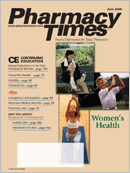Publication
Article
Pharmacy Times
ARTHRITIS WATCH
Arthritis Care Lacking in Elderly
According to a recent study, many older Americans with arthritis are not getting the proper care they need, and, when they do receive medications for their pain, they are not told about the potential side effects.
These results came from a study in which researchers sat down and talked to patients about their care, rather than relying on information received from insurance claims or patients' medical records.
The researchers interviewed 339 patients aged 75 years and older who had been diagnosed with osteoarthritis (OA). These patients claimed that they received the recommended care only 57% of the time. Only 44% of the patients were told about the potential adverse effects of their OA medications.
According to study author David A. Ganz, MD, MPH, at the University of California, Los Angeles, the frail condition of individuals with arthritis makes them more susceptible to the side effects of pain medications. One third of those interviewed reported 1 of 3 major problems of advanced age: falls, urinary incontinence, or loss of mental function, Dr. Ganz stated. Even OTC medications can cause problems in these patients, and the patients need to be alerted to these problems by their health care providers, he said.
Arthritis and Lupus Both Raise Risks in Pregnancy
Women with lupus or rheumatoid arthritis (RA) face an increased risk of pregnancy complications, according to the results of a new study conducted by a team from the Stanford University School of Medicine in Palo Alto, Calif. The investigators said that "women with common rheumatic diseases appeared to have an increased risk of adverse outcomes of pregnancy and should undergo careful antenatal monitoring in order to minimize any consequences." The results were published in the March 7, 2006, issue of Arthritis & Rheumatism.
The researchers studied data from a 2002 nationwide inpatient survey of rates of pregnancy complications, and they compared the rates of women in the general population with those of women with lupus, RA, or other conditions. They found that, in the general population, high blood pressure problems were reported in 7.8% of pregnancies, and 26.5% of all deliveries were cesarean. The rates for women with lupus, however, were 23.3% and 39.4%, respectively. Also, retarded growth of the baby in the womb happened >3 times more often in women with lupus than in women in general.
Women with RA had rates similar to those with lupus. The researchers point out, however, that "relatively large numbers of women with these rheumatic conditions do choose to bear children, and?the majority appear to have good pregnancy outcomes."
New Treatment for Juvenile Arthritis Unveiled
A new technique for bringing pain relief to children who suffer from juvenile arthritis (JA) was presented, based on a study sponsored by Children's Hospital in Philadelphia, Pa. Interventional radiologist Kevin Baskin, MD, outlined his method of injecting steroids into the ankle joint of JA patients at the Society of Interventional Radiology's 31st Annual Scientific Meeting. Dr. Baskin explained that, "with this image-guided technique, we now have an accurate way to treat this disease in its earliest stage."
He said that imaging allows physicians to deliver the medicine directly into the affected, inflamed joints. The study showed a 91% clinical improvement that lasted a mean of 1.3 years after the initial injection. A total of 55 injections were performed on 38 children. Clinical improvement was observed after 50 of 55 injections (91%). Dr. Baskin stated that earlier treatment after diagnosis was more likely to have a successful outcome, and he hopes "to be able to alleviate pain and to prevent irreversible deformity before the bones fuse."
Differences in Progression Depend on Collagen
According to recent US research, the incidence of osteoarthritis (OA) is significantly higher in the knee than in the ankle, suggesting that differences in the properties of cartilage in these joints may contribute to the development of OA. The goal of the study was to determine whether differences in the structure and composition between ankle and knee cartilage also were reflected as differences in solute transport properties.
N.L. Fetter and colleagues at Duke University, Durham, NC, found that "ankle cartilage exhibited higher proteoglycan content, as well as a trend toward lower water content, suggesting that ankle cartilage has a smaller effective pore size than knee cartilage." These findings indicate that differences in the composition of ankle and knee cartilage contribute to a difference in the partition coefficient.
The results provide further support for the hypothesis that the transport properties of cartilage may play a role in the differences in the incidence of OA in these joints by altering the effective concentration of growth factors and cytokines to which chondrocytes are exposed. The findings were published in the Journal of Orthopaedic Research (February 24, 2006).







